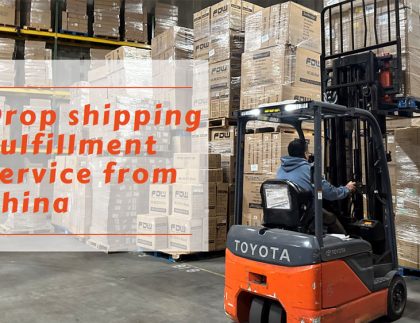The Role of Warehouse Management System(WMS) in Modern Supply Chain
In this article, we will discuss what a warehouse management system is, what it does, the different types available, the advantages of using one, and how DIDADI’s WMS can be the right choice for your e-commerce business.

In today’s fast-paced world, where customer expectations are rising, and the need for speedy and efficient delivery is paramount, warehouse management has become a critical aspect of supply chain management.
To meet these demands, end-to-end e-commerce business requires efficient and effective warehouse management systems (WMS) that streamline their warehouse operations and help them gain a competitive edge in the market.
In this article, we will discuss what a warehouse management system is, what it does, the different types available, the advantages of using one, and how DIDADI’s WMS can be the right choice for your e-commerce business.
Table of Contents
What is a Warehouse Management System?
A warehouse management system(WMS) is a software application designed to manage, control, and optimize the day-to-day operations of a warehouse or distribution center.
The system provides real-time information on inventory levels, location tracking, order fulfillment, and shipping. It helps DTC e-commerce business manage their inventory and improve their supply chain operations by providing visibility into the entire process.
Why does a WMS Plays an Important Role in Supply Chain?
A warehouse is a busy place with many operations happening simultaneously, such as receiving, storage, picking, packing, kitting, labeling, and shipping.
These tasks occur in different areas of the warehouse, making it easy for mistakes to happen, and information to be lost. When companies manage these tasks manually, it becomes even more complicated. A warehouse management system is the solution to these issues. It’s a single source of truth that uses software and automation to coordinate all activities within the warehouse. This ensures that all operations are synchronized and completed efficiently.
Types of Warehouse Management Systems
There are several types of warehouse management systems available in the market, and each one is designed to cater to the specific needs of different industries.
Standalone WMS
Standalone WMS is a basic warehouse management system that is used for managing small warehouses. It is a simple software application that can be installed on a computer, and it provides basic functionalities such as inventory tracking, order processing, and shipping. Standalone WMS is ideal for small businesses that have limited warehouse operations.
Enterprise Resource Planning (ERP) WMS
An ERP WMS is integrated into a larger ERP system, and it is used for managing warehouse operations along with other business processes. An ERP WMS provides a comprehensive solution for managing the supply chain and helps in streamlining the operations of a warehouse. It provides real-time information about inventory levels, order processing, and shipping, which helps in reducing lead times and increasing efficiency.
Cloud-based WMS
A cloud-based WMS is a web-based system that can be accessed from anywhere with an internet connection. It eliminates the need for an on-premise server and provides a flexible and scalable solution for managing warehouse operations. Cloud-based WMS is ideal for businesses that have multiple warehouses in different locations as it provides real-time visibility into inventory levels and order processing.
Integrated WMS
An integrated WMS is a comprehensive solution that combines the functionalities of various systems such as warehouse management, transportation management, and order management. It provides a centralized platform for managing all the aspects of the supply chain and helps in optimizing the operations of a warehouse. An integrated WMS is ideal for large businesses that have complex supply chain operations.
Third-party Logistics (3PL) WMS
A 3PL WMS is a specialized system that is used by third-party logistics providers to manage the operations of their warehouses. It provides functionalities such as inventory tracking, order processing, and shipping, along with additional features such as billing and invoicing. A 3PL WMS is ideal for businesses that outsource their warehousing operations to a third-party logistics provider.
Click here to get a quotation on Third-party Logistics (3PL) WMS
Advantages of a Warehouse Management System
WMS provides a wide range of benefits that can help organizations to streamline their operations, reduce costs, and improve customer satisfaction. Below we will discuss some of the key advantages of a warehouse management system.
Improved Inventory Management
One of the most significant benefits of a WMS is improved inventory management. With a WMS, you can accurately track the location and movement of inventory within the warehouse, ensuring that products are always in the right place at the right time. This helps to reduce the risk of stockouts and overstocks, which can lead to lost sales and excess inventory costs.
Increased Efficiency
A WMS can also increase warehouse efficiency by automating key processes such as receiving, putaway, picking, and shipping. By automating these processes, warehouse staff can spend less time on manual tasks and more time on value-added activities such as improving customer service or finding ways to optimize warehouse operations.
Reduced Labor Costs
Implementing a WMS can help organizations to reduce labor costs by:
● Automating many of the manual tasks that are typically performed by warehouse workers, which can help reduce the number of workers required to perform these tasks.
● Optimizing warehouse labor by providing real-time data on worker performance and productivity to allocate labor resources more effectively.
● Identifying areas where workers may require additional training or support.
● Prioritizing tasks based on their importance and urgency. By assigning workers to the most critical tasks first, labor can be used more efficiently and effectively.
Improved Customer Satisfaction
A WMS can also improve customer satisfaction by ensuring that products are delivered on time and in the right condition. By accurately tracking inventory levels and movement, organizations can reduce the risk of stockouts and delays in order fulfillment, which can lead to dissatisfied customers.
Increased Visibility
A WMS provides increased visibility into warehouse operations, enabling organizations to identify inefficiencies and areas for improvement. By monitoring key performance indicators (KPIs) such as inventory accuracy, order cycle time, and picking accuracy, organizations can identify areas where they can make improvements and optimize warehouse operations.
Why is DIDADI’s WMS the right choice for you?
DIDAD has a best-in-class warehouse management system,e-commerce business can leverage DIDADI’s fulfillment services in any of our fulfillment centers across US, UK and EU to improve cross-border shipping, decrease expenses, and accelerate deliveries.
As a 3PL, DIDADI provides end-to-end fulfillment outsourcing, with our own WMS software, you can manage your inventory, orders, and shipments with ease, and know what’s going on in our warehouses where your products are stored at all time.
To discover how DIDADI can help enhance your e-commerce business warehouse management, click the here to request a quote.
Start your ship now!
- Improve your cross-border shipping
- Decrease expenses
- Accelerate deliveries









